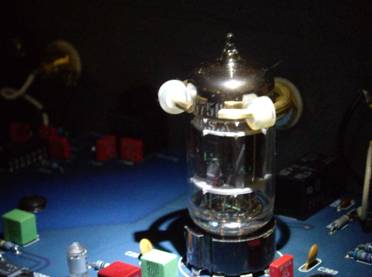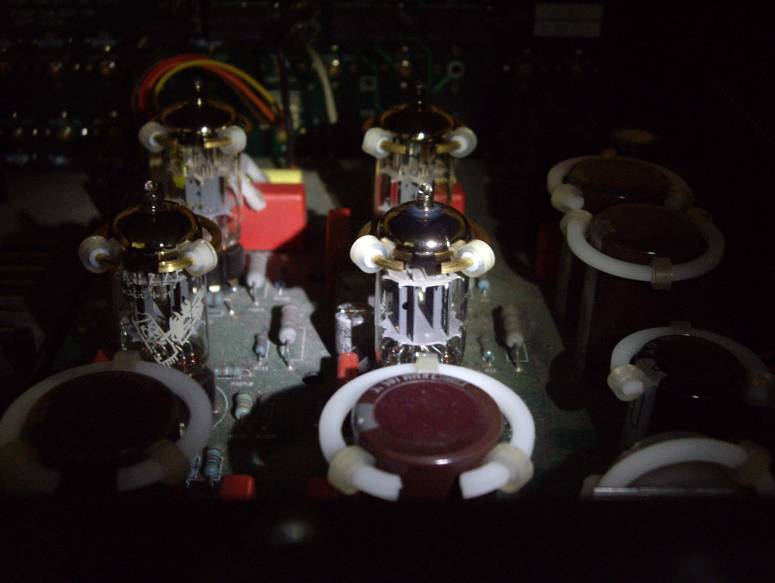Reviews
Test report: ZA-D23 Tube damper
Test report: ZA-D23 Tube damper



 ฿฿฿
฿฿฿
The principle:
"Microphonics describes the phenomenon where certain components in electronic devices transform mechanical vibrations (ringing) into an undesired electrical signal (noise). The term is derived by analogy to older microphones where that behavior is inherent in the design, while with modern electronics it is sometimes an intentionally added effect.
When electronic equipment was built using vacuum tubes, microphonics used to be a very serious design problem. The charged elements in the vacuum tubes would vibrate and the motion would change the distance between the elements, producing charge flows in and out of the tube in a manner identical to a capacitor microphone. A system sufficiently susceptible to microphonics could experience feedback.
With the advent of solid state electronics (transistors), this major source of microphonics was eliminated but smaller sources still remain. The ceramic dielectrics used in high-K capacitors ("Z5U" and "X7R") are piezoelectric and will directly transform mechanical vibration into a voltage in exactly the same fashion as a ceramic microphone. Wiring and cables can also exhibit microphonics as charged conductors move around and various materials can develop triboelectric ("static") charges that couple to the electronic circuits.
The sound of guitar amplifiers that incorporate the electronic chassis into the same cabinet as the speaker are susceptible to microphonics. Though a guitar amplifier's microphonics distortion is sometimes appreciated as part of the "special sound" of a guitar amplifier, a faulty vacuum tube or other component can cause out of control feedback. Unwanted microphonics-related audible distortions can often be alleviated by using commercially available vacuum tube dampers." ( Articles from Wikipedia, the free encyclopedia )
We all know tubes are microphonic in some way.
- 1) Transformer hum? circuits/chassis? tube sockets? tube pins? tube grid.
- 2) Loudspeakers? sound wave? circuits/chassis? tube sockets? tube pins? tube grid.
- 3) Loudspeakers? sound wave? tube glass? tube mica? tube plates? tube grid.
ZA-D23 Tube dampers; By ZODIAC ACOUSTICS

For:
9-pin tubes and all tubes ?3/4"- ?7/8 (?19m?22mm), including 12AX7, 12AT7, 12AU7, 6DJ8, 6922, 6BQ5/EL84, 6CA4/EZ81, and other glass types having the 9-pin base.
Positioning:
It was quite easy, the ZA-D23 slips onto the vacuum tubes very easily . We suggest to place the tube damper at about 1/4 the way down from the top.(Please note, this is the part where the getter is, and supposed to be hot to make the getters work better). You can experiment and try different locations to see what works best for your HI-FI system.
Reference system:
- Pre Amp : VTL TL 2.5 ( 2 x 12AU7 Amperex Bugle Boy, 2 x 12AT7 RFT )
- Power Amp : MSD - A400S
- CD Player : Arcam CD73
- D/A : California Audio Lab Sigma II ( 5751 Syvania 3 Mica )
- Speakers : Canton LE 107
- Speaker Cables : Transparent Music Chord
- Interconnect Cables : MIT Digital Reference, JPS Super Conductor, Nordost Hiemdall
- Power Cords : JPS Power AC, Acoustic Zen Tsunami MKII, Supra Lorad
Installation Step 1: CAL sigma II with ZA-D23 & VTL TL2.5 without ZA-D23
First of listening, without the ZA-D23 tube dampers in my reference system. I started with my current reference CD, Opus 3 "Test CD 4.1", and played the track No.16, "House Of The Rising Sun". This track has a very impression of percussion transient. This piece makes it easy to place them in depth and width of the stereo picture, so that they very nearly encircle the vocalist. I replayed this track again and again until I remembered three important subject fields for sound experience: depth of image, timbre, dynamics. Next, with the ZA-D23 on the 5751 of CAL Sigma II, at the tube about 1/4 of the way down from the top. I replayed the track No.16 (House Of The Rising Sun). The depth of image, timbre and dynamics sounded better than without the ZA-D23. In different position, the ZA-D23 was placed at about 1/3 of the way down from the top. Comparing the sound qualities, the second trial had a bit less depth of image, also timbre and dynamics but better than without them. The best position of the ZA-D23 for vacuum tubes in CAL sigma II are at about 1/4 of the way down from the top.
Installation Step 2: CAL sigma II & VTL TL2.5 with ZA-D23

After installing the ZA-D23 onto the tube of CAL
Sigma II, I were experiment and try different locations of the ZA-D23 tube dampers onto my VTL TL2.5 (2?12AU7, 2?12AT7). Once again, I played the reference CD, Opus 3 "Test CD 4.1", the track No.16, "House Of The Rising Sun" for comparing the sound qualities. The best position of the ZA-D23 tube dampers for the 12AU7 Amperex Bugle Boy and 12AT7 RFT in VTL TL2.5 were the same area in CAL Sigma II.
On Test:
On "House Of The Rising Sun", Test CD 4.1, At the beginning of this session, I was amazing that the sound of a Triangle on the left and a cymbal on the right is very clear with power. The brilliant timbre of the attacks had more airy, more extended and clean on top, and not even sharp or harsh. The soundstage had deeper and wider. The overall presentation had greater bass impact and clearer highs. The percussion had more transient than without the ZA-D23 in place. The strings and double bass had low, dense and well-define sound. The sax had more open and full-bodied sound. Cyndee Peter's voice sounded natural and had more airy than without the ZA-D23 in place. Her lovely voice conveys both powerful and tenderness, wisdom and love.
On "Way Down Deep", Jennifer Warnes' "The Hunter", I have heard a hundred times, until I heard once again on my HI-FI system with the ZA-D23 tube dampers. At the beginning of this piece, I was amazing that the sound of the surdo (bass drum) more powerful like having air pressure, good punch and very deep. Other percussion sounded larger and richer in tone; and even other instruments you wouldn't normally expect, such as the seed-pod rattle, lost a bit of harshness and more fullfill sounded. Musical details were clearer, more delineated, more airy and ambience, nice extension on top with a great sense of vibrancy. It was like everything in focus. Before applying the ZA-D23 tube dampers, the lap steel guitar was located a bit behind the middle and blurred, but after putting the dampers on, not only did the lap steel guitar clarity increase, it moved more backward. The talking drum moved further to the left, revealing a terrific increase in the soundstage.
On "Hey You", Pink Floyd "The Wall", After I placed the ZA-D23 to all tubes of my system, it made a wonderful improvement in the quality of sound. It started off with a solo acoustic guitar playing in the classical style. Its sound had more open, more extended and clean on top, and not sharp or harsh. The bass slightly sounded deeper in shortly after. Next to joined with the synthesizer that sounded more vibrancy, the vocals had more full-bodied sound. Finally the drums at about 1:57 of time scale, solo perform of the drum set had more air pressure, good deep punch.
The sound of the cymbals had more clear, and more extended. At about 2:01 of time scale, Gilmour's solo had more clear, and very sweet as well. During this time, the rhythm guitar sounded had a better detail. At about 3:23 of time scale, the sound affect of the atmosphere and emptiness sounded more realistic with a reduction of harshness. With the ZA-D23 in place individual instruments was played more life-like and was easier to place around you because everything had more space or air around. They have made the soundstage deeper and wider. This makes a lot more sense than changing cables.
Summery:
The useful of ZA-D23 are
The useful of ZA-D23 are
- : Reduces the harshness
- : Make larger and richer in tone
- : More extended and clean on top
- : More airy, ambience and vibrancy
- : More transient and deep bass
- : Better image and soundstage
" That why I don't even think to live without ZA-D23 "
Pricing : 500 Bht./pair
Available at www.musicfountain.net
Reviews
- Origin Live Ultra The Perfectionist
- ทดลองฟัง Viola PH1 model 2
- TS Audio Phono Stage PH-1 The Vacuum Tube with Decent Price
- NAD PP-1 Phono Stage The Good Budget Phono Stage in Town.
- VCL Prestige Phono Stage Too Bright for Tube Lover.
- Rega RB250 Incognito Upgrade
- Viola PH1 The Inspiration Phono Stage.
- PHR Speaker Worth to hear Thai modification
- Test report: ZA-D23 Tube damper
- Review Origin Live Aurora MKII









